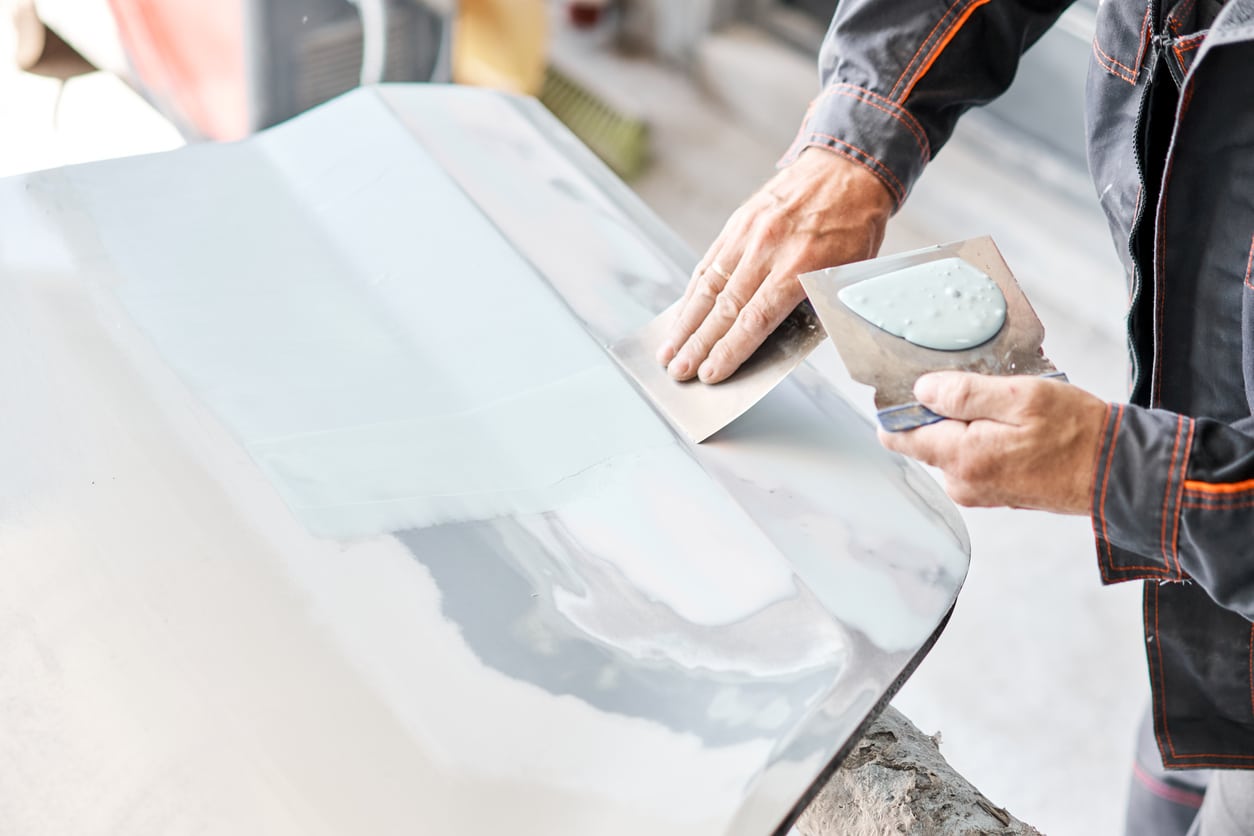Automotive body filler is commonly used by professionals for quick repairs to minor damage on a car’s exterior surface. It can be perfect for scratches, dents and even for treating rust perforations. But if you fail to follow the proper steps throughout the process, the car’s surface could be left with further imperfections requiring additional repair work.
Here, we’ll explain how to get the best results when working with car body filler. From mixing to application and sanding, we’ve collated our best tips to help you achieve the perfect finish every time.
Choosing the Right Filler: Different Types of Automotive Body Filler
Automotive body fillers will usually fall into three distinct categories: standard, medium and premium grade. Each one consists of polyester resin and hardener, which can either be found pre-mixed or, more often with professional fillers, separated. The filler grade you choose will depend on the type and size of repair you’re working with. Below, we’ll guide you through each option and the situations that call for its use.
Standard
A standard-grade body filler is lightweight, easy to spread and dries in around 20-25 minutes. Standard body filler sands down easily to blend seamlessly with the rest of a vehicle’s surface with proper priming and painting, making it perfect for working on minor dents and scratches. Standard filler can be the easiest to source and is usually the most inexpensive option available.
However, one of its main disadvantages is that it doesn’t offer stain resistance which means that color from the filler can stain the surface you’re working on. It’s also not recommended for use on galvanised steel.
Medium
Medium-grade body fillers are typically fibreglass-filled and offer a higher-quality finish than standard fillers. Because of this, they adhere well to a variety of body surfaces like metal and fibreglass, have better stain resistance and work well for repairing small holes or cracks.
On the other hand, the reinforced nature of this filler can make it more difficult to work with. It often takes some time to get used to the more rigid formula, so it’s best to spend some time practising with your application.
Premium
Made from top-quality resin that benefits from the highest stain resistance of the three options, premium-grade body filler is the best to use when high-quality work is required. The premium option is the easiest to sand down and offers the best adhesion, making it ideal for repairing larger areas of a vehicle.
Although this is the most expensive automotive body filler option available, it’s the easiest to finish and usually doesn’t require the same putty or glaze layer that the others might need.
Where to Use Auto Body Filler
Auto body filler can be used in multiple locations on a car’s exterior. Below, we’ll take you through where’s best to use it and why.

Small holes and dents
Small holes and dents in the paintwork of a car can expose the bare metal underneath. The longer that this is exposed to the elements, the more likely it is to be affected by weathering or rust which can spread and affect the integrity of the car’s surface. Fixing holes or dents using filler can prevent further issues and leave the bodywork looking as good as new again.
Below paint level scratches
Scratches that are deeper than paint level can be a serious issue for the metal of a vehicle’s body. Filler can be a great solution for this since it builds up the layers to prevent weathering or rust from penetrating the base of the vehicle’s body. Layering filler can seal the scratches ready for re-painting, which also means that the issue can be fixed without the need to replace an entire body panel.
How to Apply Body Filler on a Car: Step-by-Step
For the best auto body filler application, we recommend following our step-by-step instructions below.
1. Prepare the surface
Before applying filler, it’s important to adequately prepare the vehicle’s surface. This will ensure that the filler sticks properly and doesn’t end up lifting off or separating from the bodywork. To do this, clean the area using warm water and a clean microfibre cloth. You can also apply bodywork shampoo to remove more stubborn marks.
After thoroughly cleaning the area and removing any dirt or debris, apply a good-quality primer to help the filler stick. Once this dries, it’s time to rough up the surface using coarse sandpaper. A rough surface allows the filler to grip and bond to the vehicle, which should prevent lifting later in the process.
Finally, use a degreaser in the area you’re working on. This will ensure the surface is clean and ready for filler application.

2. Apply the filler
Once you’ve chosen the correct automotive body filler for the repair job at hand, you’ll either need to mix it which we’ll explain how to do later in this blog, or it’ll be ready for application immediately.
To apply your filler, you’ll need a plastic spreader. This can pick up small amounts of filler and evenly deposit the mixture into the dent, hole or imperfection. Next, take a steel ruler and use the edge of this to smooth the filler. By doing this, you can get a better idea of how many layers might be needed while also removing the excess filler to help with the sanding process.
This should be repeated for each layer as necessary.
3. Sand each layer until you reach the desired finish
After each layer dries completely, take a fine-grit sanding paper and carefully sand down the filler. The number of layers you’ll need will depend on the type and size of the repair, so be sure to carefully assess the progress as you add each one.
For applications using standard or medium-grade filler, it’s usually necessary to add a layer of putty to the area for the smoothest possible finish. Again, use a plastic spreader to apply this and run the steel ruler across it to smooth the layer, ensuring it’s as even as possible. Leave this to dry for around 24 hours before re-painting the surface with your choice of car paint.
How to Mix Car Body Filler
Before you start mixing the filler, make sure your area is clear of dust or other debris that could cause contamination and that your tools are suitably cleaned. It’s important to remember that bits of hardened filler from previous jobs can become dislodged in the new filler and spoil your application.

It’s best to mix filler on a non-porous surface since this won’t absorb any of the product or affect the cure. It might seem handy to mix filler on a piece of cardboard, for example, but this surface is more likely to absorb the product and entrap air into the mix and cause pin-holding on the surface.
Start by mixing smaller amounts, regardless of the quantity you think will be needed for the repair. The smaller the batches are, the easier they’ll be to work with, and you’ll be less likely to throw away filler that’s cured too quickly or exceeds the needs of the job.
The filler should come with instructions for mixing, so be sure to follow this advice carefully and mix the correct proportions. The filler should be thoroughly mixed with just the right amount of hardener. Adding too much can lead to issues with curing and leave you with a brittle fill prone to cracking. It’s also important that the two components are thoroughly mixed since pockets of filler without hardener won’t cure properly. Once there aren’t any visible streaks from the colored hardener, the mixture should be ready to use.
How to Sand Car Body Filler
For the best application, it’s best to allow your filler to dry fully between coats and sand lightly with a fine-grit sandpaper between each one. Not only will this ensure that each layer sticks to the surface properly, but it’ll also give you the chance to check on the progress as you add the filler.
The filler should sit just a little lower than the surface of the rest of the vehicle after your final pass with the sanding paper to allow room for re-painting and finishing.
Car Body Filler FAQs

Still have a few unanswered questions about car body filler? Below, we’ve answered a few of the most frequently asked questions about this process to help auto repair workers achieve the best filler application.
How long does filler take to dry?
The length of time it takes for auto filler to dry will depend on whether you’re applying standard, medium or premium-grade filler. The curing time can also be affected by the amount of filler you’re applying and the size of the area you’re trying to fill. Generally speaking, though, a layer of filler should take around half an hour to dry completely.
Where should I not use body filler?
Body filler shouldn’t be used on the following:
- Rust: Body filler won’t be able to stick properly to a rusted surface and will more than likely leave you with a bumpy finish. Any rust present must be fully removed before applying auto filler.
- Full gas tanks: Auto filler is flammable and only becomes resistant to gas after the curing stage.
- Anywhere that becomes overly hot: When filler gets too hot during application, it can cure too quickly and leave you with an uneven application that’s difficult to rectify.
How do I thin auto body filler?
Lacquer thinner is the best product for thinning a solvent-based filler, although it’s worth being mindful that this will increase the amount of shrinkage on curing. Acetone can also be a popular thinning agent, although the mix needs to be exact to prevent issues when curing. We recommend sticking to lacquer thinner for the best results. This should be applied slowly during the mixing process to ensure you’re not adding too much.
Can auto filler be used on a painted surface?
Some more modern car body fillers can be used over a painted surface with no issues. However, we recommend sanding down the paint first to reveal the bare metal before filling and re-painting. Filling over paint can leave obvious lines where the damage has been repaired which can affect the overall appearance of the vehicle.
Applying the filler over the metal gives it the best chance of sticking to the car body properly and allows you to work on building each layer back up. Our Flexi No Edge Blending Tape can be used around the area to help achieve the perfect finish when it comes to the painting and sealing process.
Whether you’re new to the automotive repair industry or are looking for a refresher on best practices for body filler application, we hope this guide comes in handy and shows just how easy it can be to achieve the perfect finish on your repair job.
Looking for more expert advice? Check out our blog.

